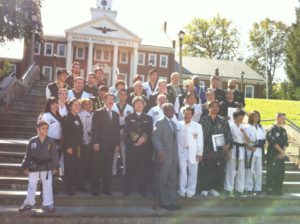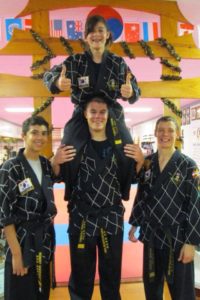Hwa Rang Do is a traditional Korean martial art that teaches the individual to live within humanity, to live with compassion, and to live with self dignity as they strive to better themselves to achieve harmony in mind and body.
About
 Grand Master Ki Tae Yum: Grand Master Ki Tae Yum is the master of Shilla Hwa Rang Do. He hold the rank of 8th Degree Black Belt. Master Yum first started teaching Hwa Rang do when he opened a school in the Philippines where he taught many students for six years. in 1991 Master Yum moved to the United States and opened a new school in Old Bridge, New Jersey. Ten years later in 2001 he moved to Sarasota, Florida where he opened his most recent school. Here he continues to teach and impact the next generation of martial artists.
Grand Master Ki Tae Yum: Grand Master Ki Tae Yum is the master of Shilla Hwa Rang Do. He hold the rank of 8th Degree Black Belt. Master Yum first started teaching Hwa Rang do when he opened a school in the Philippines where he taught many students for six years. in 1991 Master Yum moved to the United States and opened a new school in Old Bridge, New Jersey. Ten years later in 2001 he moved to Sarasota, Florida where he opened his most recent school. Here he continues to teach and impact the next generation of martial artists.
 Sa Bum Nim Michael Warren: Michael Warren is a 3rd Degree Black Belt under Master Yum. He has been training at Shilla Hwa Rang Do for thirteen years. He is highly skilled in Hwa Rang Do from the basics that every student learns to the advanced weapon techniques of the black belts. In addition to teaching techniques to student he also teaches the mental aspects of Hwa Rang Do and encourages students to use what they learn in class in all aspects of their life. He is a honored to be able to help teach future martial artists each and every day.
Sa Bum Nim Michael Warren: Michael Warren is a 3rd Degree Black Belt under Master Yum. He has been training at Shilla Hwa Rang Do for thirteen years. He is highly skilled in Hwa Rang Do from the basics that every student learns to the advanced weapon techniques of the black belts. In addition to teaching techniques to student he also teaches the mental aspects of Hwa Rang Do and encourages students to use what they learn in class in all aspects of their life. He is a honored to be able to help teach future martial artists each and every day. History
The modern martial art called Hwa Rang Do was first brought to the public as a traditional Korean martial art based in Seoul, South Korea in the early 1960’s. It is one of the premier, traditional “non sport” full spectrum martial arts to emerge out of South Korea in the 20th century. It was brought to the United States in the late 1960’s. Hwa Rang Do is a blend of hard and soft movements based on the theory of (Um & Yang) with linear and circular techniques (Kang-Sul & Yu-Sul) that can be used offensively or defensively. Hwa Rang Do also incorporates all ranges of hand strikes, kicking, joint locks, throws, falling, submission holds and ground defense techniques. It also includes the study of various aspects of unarmed and armed patterns, called Hyung. Weaponry includes the long staff, short stick, spear, sword, various types of knives and traditional archery. The student of Hwa Rang Do is also taught the inner aspect of breath control, Ki energy development and the healing methods of acupressure therapy and herbal medicine treatment. In essence, the modern art of Hwa Rang Do is the unification of the original native Korean martial skills, as well as some of the reformed Korean martial arts brought together to form one complete system with an emphasis on the aspect of molding the student’s character through understanding of the martial way called Mudo.
2. Loyalty to one’s parents and teachers.
3. Trust and brotherhood among friends.
4. Courage to never retreat in the face of the enemy.
5. Justice to never take a life without cause.
1. Humanity
2. Justice
3. Courtesy
4. Wisdom
5. Trust
6. Goodness
7. Virtue
8. Loyalty
9. Courage
Hwa Rang Do Code of Ethics
Five Rules
1. Loyalty to one’s country.2. Loyalty to one’s parents and teachers.
3. Trust and brotherhood among friends.
4. Courage to never retreat in the face of the enemy.
5. Justice to never take a life without cause.
Nine Virtues
1. Humanity
2. Justice
3. Courtesy
4. Wisdom
5. Trust
6. Goodness
7. Virtue
8. Loyalty
9. Courage










